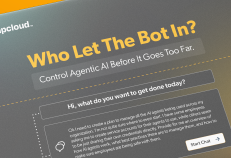Agentic AI has become an important part of day-to-day business operations. Today, 82% of organizations use AI agents to automate tasks, analyze data, and make decisions that previously required human oversight.
These agents offer speed, scale, and efficiency — but also introduce serious, often overlooked security risks.
[Blockquote: 96% of IT leaders recognize agentic AI as a growing security threat.]
The problem? Most security frameworks weren’t designed for autonomous systems. They were built for environments where humans initiate actions and software follows fixed logic.
Agentic AI upends that model. These agents can observe, learn, make independent decisions, and take action — without waiting for human input. That level of autonomy brings unpredictability that traditional tools can’t govern.
To fully realize the benefits of agentic AI without exposing the business to new risks, organizations need a different approach. That starts with identifying the unique threats these agents pose and putting governance in place from the start.
The Risks Agentic AI Introduces
When agentic AI is deployed without clear oversight, it creates vulnerabilities that impact security, operations, and compliance. Here are the key risks organizations face when agents operate unmanaged:
Most organizations lack formal policies for managing autonomous systems. Without centralized rules, teams create their own — resulting in fragmented oversight and uneven enforcement. These inconsistencies lead to gaps no one is responsible for closing.
Agentic AI behaves dynamically and operates across systems in real time. Traditional monitoring tools aren’t built to track these autonomous actions. Without continuous visibility and detailed audit trails, risky behavior can go undetected until it’s too late.
AI agents are often deployed directly by business teams without involving security. This rapid, decentralized adoption bypasses critical review processes, which leads to inconsistent controls, misconfigured access, and unmonitored behavior in sensitive environments.
AI agents don’t request access like human users do. To avoid friction, teams often grant excessive permissions up front. This over-provisioning expands the attack surface. On the flip side, overly restrictive access can block functionality. Neither approach is sustainable without precise, adaptive access controls.
Autonomous agents act quickly, often without human validation. A small misjudgment or outdated rule can trigger a chain reaction of unintended consequences across systems. And because agents operate continuously and at scale, their errors can escalate faster — and often with fewer early warning signs than human-driven processes.
The Consequences of Unchecked Agentic AI
When agentic AI operates without governance, the risks translate into real business consequences. Left unchecked, autonomous agents can create issues that are difficult to detect and expensive to fix. These issues fall into the following categories:
AI agents often interact with large volumes of sensitive data. Without precise access controls, they may pull, move, or expose information they were never intended to access — violating internal policies or regulatory requirements.
Agents acting independently can take conflicting or harmful actions. Actions that can modify systems, issue commands, or initiate workflows that break critical processes. What starts as a small misstep can quickly escalate into system-wide outages.
Without a clear record of what an agent did and why, post-incident investigations stall. Security teams struggle to determine root causes, making it harder to contain damage, learn from errors, or meet compliance obligations.
Untracked agent behavior can lead to non-compliance with regulations like GDPR, HIPAA, or SOX. These violations may be unintentional, but regulators won’t see it that way. Fines and reputational damage follow no matter what your intention is.
Employees, partners, and customers expect responsible AI use. If agents behave unpredictably or cause harm, the result is a loss of trust — both in the technology and in the teams deploying it.
Preventing Agentic AI from Becoming a Security Nightmare
To safely scale agentic AI, organizations need identity-first governance. This means every agent is treated as an identity, every action is permissioned, and every behavior is traceable.
1. Treat Agents as Identities
Assign each agent a unique, managed identity:
- Apply role-based access controls.
- Rotate credentials regularly.
- Track activity across the full lifecycle — onboarding, role updates, and decommissioning.
This lets you manage agents with the same rigor you apply to human users.
2. Apply the Principle of Least Privilege
Avoid giving agents broad or permanent access just to get them running:
- Grant only the access needed for their current function.
- Use deny-by-default as a baseline.
- Enforce time-bound access and approvals for high-risk actions.
Revisit permissions as agent roles evolve to avoid unnecessary exposure.
3. Build Visibility into Agent Behavior
Oversight starts with observability:
- Monitor agent activity continuously.
- Centralize logs and capture decision context.
- Set up real-time alerts tied to defined policies.
You should be able to trace every action back to a specific agent and explain why it occurred.
4. Establish Shared Responsibility
Governance isn’t just IT’s job. Business owners deploying agents must take responsibility for managing their impact.
- Assign clear ownership.
- Set and enforce behavioral boundaries.
- Review performance and compliance regularly.
Security defines the guardrails, but business leaders must help keep agents in bounds.
Control Agentic AI Before It Controls You
Agentic AI is becoming core to business operations. But when autonomy goes unchecked, it opens the door to risk.
Innovation doesn’t need to pause, but it does need parameters. The key is building governance that defines permissions, tracks behavior, and enforces accountability for every autonomous agent.
So what can you do? Treat agents like identities. Scope access to their roles. Monitor behavior continuously. And ensure both security and business teams share responsibility. With the right controls, agentic AI can move your business forward — without compromising security.
For a deeper dive into the risks and consequences of unmanaged agentic AI, download the eBook Who Let the Bot In?.





